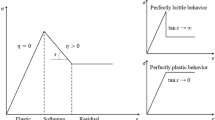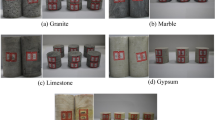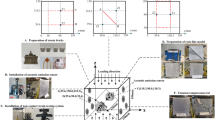Abstract
The weakening effect of hydrostatic pressure (P w) on rock mass is an important topic in the field of underground construction. In this article, a new technique is introduced to simulate the mechanical conditions and geological processes of rock mass formation using the MTS815 Rock Mechanics Test System. With this technique, intact rock specimens of marble, sandslate, greenschist, and lamprophyre acquired from rock masses are transformed into rock mass replica specimens with structural planes whose major mechanical characteristics resemble the target rock masses. These replica specimens are subjected to hydro-mechanical interacted tri-axial compression tests to reveal the weakening effect of the hydrostatic pressure on the rock mass. The experimental results show that hydrostatic pressures of 1–4 MPa have a significant effect on the mechanical properties of the rock masses. The internal cohesion c decreased dramatically when the hydrostatic pressure increased; however, the increased pressure had less effect on the internal friction coefficient μ. The deformation modulus decreased when the hydrostatic pressure increased under low confining pressure, but barely changed when the confining pressure rose above 20 MPa. These results have provided an important basis for engineering construction planning and have created a new effective way for laboratory studies of rock mass mechanical properties.











Similar content being viewed by others
References
Amader B, Wibowo J, Sture S et al (1998) Applicability of existing models to predict the behavior of replicas of natural fractures of welded tuff under different boundary conditions. Geotech Geol Eng 16(2):79–128
Aureli F, Mignosa P, Tomirotti M (2000) Numerical simulation and experimental verification of dam-break flows with shocks. J Hydraul Res 38(3):197–206. doi:10.1080/00221680009498337
Barton N, Bandis S, Strength Bakhtar K (1985) Deformation and conductivity coupling of rock joints. Int J Rock Mech Min Sci Geomech Abstr 22:121–140
Chen Z, Narayan SP, Yang Z et al (2000) An experimental investigation of hydraulic behavior of fractures and joints in granitic rock. Int J Rock Mech Min Sci 37(7):1061–1071
Grassellia G, Egger P (2003) Constitutive law for the shear strength of rock joints based on three-dimensional surface parameters.pdf. Int J Rock Mech Min Sci 40(1):25–40
Hoek E, Brown E (1997) Practical estimates of rock mass strength. Int J Rock Mech Min Sci 34(8):1165–1186
HydroChina Chengdu Engineering Corporation (2003) Engineering geology. Feasibility study report for Jinping I hydropower station
Kovari K, Tisa A et al (1983) Suggested methods for determining the strength of rock materials in triaxial compression: revised version. Int J Rock Mech Min Sci 20(6):283–290
Lajtai E, Schmidtke R, Bielus L (1987) The effect of water on the time-dependent deformation and fracture of a granite. Int J Rock Mech Min Sci Geomech Abstr 24(4):245–255
Mas Ivars D (2006) Water inflow into excavations in fractured rock—a three-dimensional hydro-mechanical numerical study. Int J Rock Mech Min Sci 43(5):705–725. doi:10.1016/j.ijrmms.2005.11.009
Masuda K (2001) Effects of water on rock strength in a brittle regime. J Struct Geol 23(11):1653–1657
National Standards Compilation Group of China (1999) GB/T50266-99. Standard for tests method of engineering rock masses[S]. China Planning Press, Beijing (in Chinese)
Oda M (1986) An equivalent continuum model for coupled stress and fluid flow analysis in jointed rock masses. Water Resour Res 22(13):1845–1856
Olsson R, Barton N (2001) An improved model for hydromechanical coupling during shearing of rock joints. Int J Rock Mech Min Sci 38(3):317–329
Rutqvist J, Stephansson O (2003) The role of hydromechanical coupling in fractured rock engineering. Hydrogeol J 11(1):7–40. doi:10.1007/s10040-002-0241-5
Rutqvist J, Wu Y, Tsang C, Bodvarsson G (2006) A modeling approach for analysis of coupled multiphase fluid flow, heat transfer, and deformation in fractured porous rock. Int J Rock Mech Min Sci 43(5):705–725
The Professional Standards Compilation Group of People’s Republic of China (2007) DL/T5368–2007 Code for rock tests of hydroelectric and water conservancy engineering[S]. China Water Power Press, Beijing (in Chinese)
Xu M, Xu J, Ren H (2012) Water pressure–stress coupling tests on the mechanical properties of marble rock. J Yangtze River Sci Res Inst 29(8):34–38
Yin M, Liu Q, Huang C (2012) Experimental study on mechanical properties of weak rock mass obtained from dyke under interstitial hydraulic pressure. South-to-North Water Transf Water Sci Technol 10(4):76–80
Acknowledgments
The authors are grateful for the financial support from the National Natural Science Foundation of China (Grant Nos. 51120145001, 51374148), the National Basic Research Projects of China (Grant No. 2011CB201201), the CERS-China Equipment and Education Resources System (CERS-1-114), and the Fundamental Research Funds for the Central Universities (Grant No. 2014SCU04A07). The authors wish to offer their gratitude and regards to the colleagues who contributed to this work. The authors also wish to thank the editors and anonymous reviewers for providing critical comments and constructive suggestions in revising this article.
Author information
Authors and Affiliations
Corresponding author
Rights and permissions
About this article
Cite this article
Xu, H., Liu, J., Wang, L. et al. The weakening effect of hydrostatic pressure on rock mass of different lithology. Environ Earth Sci 74, 2489–2497 (2015). https://doi.org/10.1007/s12665-015-4255-4
Received:
Accepted:
Published:
Issue Date:
DOI: https://doi.org/10.1007/s12665-015-4255-4




